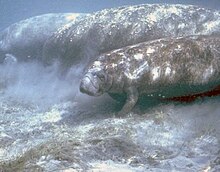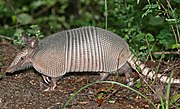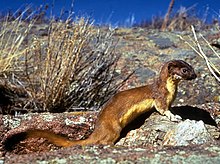|
List of mammals of PanamaThis is a list of the mammal species recorded in Panama. Among the mammals in Panama, two are classified as critically endangered, seven are endangered, eleven are vulnerable and three are near threatened. One species is classified as extinct.[1] The following tags are used to highlight each species' conservation status according to assessment done by the International Union for Conservation of Nature:
In the table below, the species were assessed by using an older set of criteria. Species assessed using this system are classified as the following instead of near threatened and least concern categories:
Subclass: TheriaInfraclass: MetatheriaOrder: Didelphimorphia (common opossums) Didelphimorphia is the order of common opossums of the Western Hemisphere. Opossums probably diverged from the basic South American marsupials in the late Cretaceous or early Paleocene. They are small to medium-sized marsupials, about the size of a large house cat, with a long snout and prehensile tail.
Infraclass: EutheriaOrder: Sirenia (manatees and dugongs) Sirenia is an order of fully aquatic, herbivorous mammals that inhabit rivers, estuaries, coastal marine waters, swamps, and marine wetlands. All four species are endangered.
Order: Cingulata (armadillos) Armadillos are small mammals with a bony armored shell. Two of twenty-one extant species are still present in Panama; the remainder are only found in South America, where they originated. Their much larger relatives, the pampatheres and glyptodonts, once lived in North and South America but went extinct following the appearance of humans.
Order: Pilosa (anteaters, sloths and tamanduas)   The order Pilosa is extant only in the Americas and includes the anteaters, sloths, and tamanduas.
Order: Primates   The order Primates includes humans and their closest relatives: lemurs, lorisoids, tarsiers, monkeys, and apes. All the non-human Panamanian primates are New World monkeys.
Order: Rodentia (rodents) Rodents make up the largest order of mammals, with over 40% of mammalian species. They have two incisors in the upper and lower jaw which grow continually and must be kept short by gnawing. Most rodents are small unlike the capybara which can weigh up to 45 kg (99 lb).
Order: Lagomorpha (lagomorphs)The lagomorphs comprise two families, Leporidae (hares and rabbits), and Ochotonidae (pikas). Though they can resemble rodents, and were classified as a superfamily in that order until the early 20th century, they have since been considered a separate order. They differ from rodents in a number of physical characteristics, such as having four incisors in the upper jaw rather than two.
Order: Eulipotyphla (shrews, hedgehogs, moles, and solenodons)Eulipotyphlans are insectivorous mammals. Shrews and solenodons closely resemble mice, hedgehogs carry spines, while moles are stout-bodied burrowers.
Order: Chiroptera (bats)   The bats' most distinguishing feature is that their forelimbs are developed as wings, making them the only mammals capable of flight. Bat species account for about 20% of all mammals.
Order: Cetacea (whales)    The order Cetacea includes whales, dolphins and porpoises. They are the mammals most fully adapted to aquatic life with a spindle-shaped nearly hairless body, protected by a thick layer of blubber, and forelimbs and tail modified to provide propulsion underwater.
Order: Carnivora (carnivorans)   There are over 260 species of carnivores, the majority of which eat meat as their primary dietary item. They have a characteristic skull shape and dentition.
Order: Perissodactyla (odd-toed ungulates) The odd-toed ungulates are browsing and grazing mammals. They are usually large to very large, and have relatively simple stomachs and a large middle toe.
Order: Artiodactyla (even-toed ungulates) The even-toed ungulates are ungulates whose weight is borne about equally by the third and fourth toes, rather than mostly or entirely by the third as in perissodactyls. There are about 220 artiodactyl species, including many that are of great economic importance to humans.
See also
Notes
References
|